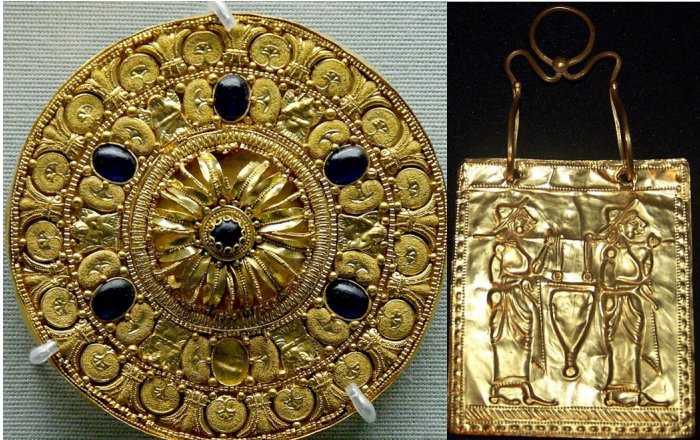Mysterious Etruscans: Skilled Sailors And Master Craftsmen
A. Sutherland - AncientPages.com - About 3000 years ago, a mysterious people called the Etruscans settled in a region of Central Italy known as Etruria. They were one of the most influential civilizations in ancient Italy before the rise of the Romans.
Although these ancient people were much closer to us in time, they were even more enigmatic and inaccessible than other ancient cultures such as Crete, Mesopotamia, or Mycenae, and we still have much to learn about them.
Researchers deciphered the language, but most Etruscan texts remain obscure because the language bears very little relation to other known languages. Scholars have recorded some thirteen thousand Etruscan inscriptions; the phonetic sounds of the Greek alphabet are known, so it also helps to reconstruct the Etruscan language's sound. At the same time, extensive texts left by this civilization are rare.
The origin of the Etruscans is lost in prehistory. According to Livy (Titus Livius, 59 BC-AD 17), the Etruscans had a rich literature, but almost all of it disappeared.
A few generations before Livy's time, young Romans studied the Etruscan literature as meticulously as they later did the Greek, but except for brief inscriptions on tombs, mirrors, or pottery, none of this work has survived. So, all we know about the Etruscans comes mainly from Greek and Roman sources. The Greeks called their land "Hesperia," and the Etruscans were called "Tyrrhenians," probably after Tyrrhenus, fifth in descent from the god Zeus and one of the founders of the Etruscan Federation of twelve cities.
Extent of Etruscan civilisation and the twelve Etruscan League cities. Image credit: Norman Einstein (Based on a map from The National Geographic Magazine Vol.173 No.6 June 1988). CC BY-SA 3.0
Ancient Etruria was situated on the western side of Italy, between the Apennines and the Tyrrhenian Sea. It extended from the land about the Arno River in the north to the Tiber River in the south and included modern Tuscany, which takes its name from the Etruscans. At one period, the Etruscans controlled Campania and the basin of the Po River and reached the northern Adriatic. Speculations regarding their origin have never ceased. Some scholars speculated they came from the Danube, while others proposed the North of the Alps region.
Herodotus claimed their arrival from Lydia, modern Anatolia in Asia Minor, but the Etruscans did not speak Lydian, worship Lydian gods or follow Lydian laws.
Many of the most famous cities in Italy were originally Etruscan. Among them are Pisa, Arezzo, Cortona, Siena, Volterra, Orvieto, Perugia, Assisi, and others also worth mentioning. Rome was once an Etruscan center, and the islands of Elba and Corsica were also Etruscan.
Left: Ear-stud decorated with a rosette surrounded by concentric bands. Gold with vitreous glass paste insets, 530–480 BC; source; Right: The Ancient Thracian Golden Orphism book, discovered in 1955, in the Struma River valley, in Bulgaria. It is exposed in the National History Museum in Sofia. Image credit: Ivorrusev - CC BY-SA 4.0
But there were other towns, either deserted or forgotten in the decline of Etruscan cultures, such as Veii, Tarquinia, Cerveteri, and Chiusi, where archeologists have found rich remains.
As scientists have not been able to study their language, they have always had to rely on the archeological excavations of their cities and numerous cemeteries. These sites, unfortunately, suffered more than two hundred-year-long plunderings before professional archaeologists could finally enter the ancient sites and begin their work in the field.
Scholars have long analyzed ancient records and tried to decipher the Etruscan inscriptions. Especially by the end of the century, many Etruscan remains were unearthed, painted, and figured pottery, gold vessels with a variety of domestic equipment in the form of candelabra, lamps, beautifully engraved mirrors, terracotta, and bronze objects.
Other priceless items found by diggings, of which many showed Greek and Roman influence - included bracelets, pendants, fibulae, rings, and other jewelry. Others, on the other hand, were not of Roman or Greek origin. They had once belonged to the enigmatic and relatively unknown civilization of people known as the Etruscans.
Discovered tomb paintings shed light on the life of the Etruscans, showing, for example, that women were given an honored place in society.
Urn in the shape of a hut, which represents the typical Etruscan house of the Villanovan phase, 8th century BC, from Vulci, Musée d'art et d'histoire de Genève. Image credit: Dom8Mi - CC BY-SA 3.0
They are depicted as banqueting with male guests and being embraced by their husbands. Also, funerary inscriptions have revealed many names of the deceased's female and male ancestors.
Etruria was rich, and the primary source of this wealth were valuable minerals concentrated in the vicinity of the Metalliferous Hills ('Colline Metallifere') with plenty of copper, iron, zinc, and tin. In exchange for these crucial minerals, the Etruscans could import ivory, silver, and gold, which they appreciated so much.
The mysterious, seafaring Etruscan civilization flourished until the end of the second century B.C. when they were finally included in Roman culture. There is still much to learn about these people, and a fascinating debate regarding the Etruscans continues.
Some scholars believe that the Etruscans were the descendants of an oriental group that settled in western Italy after 1000 BC. Meanwhile, others suggest that the Etruscans were instead an indigenous race with culture and traditions developed in Italy from the beginning. With time, their culture was only subjected to influences from the east.
However, when and where the Etruscans came to Italy is still unclear. Their roots are traced to Turkey rather than Italy.
Written by – A. Sutherland AncientPages.com Staff Writer
Updated on November 8, 2022
Copyright © AncientPages.com All rights reserved. This material may not be published, broadcast, rewritten or redistributed in whole or part without the express written permission of AncientPages.com
Expand for referencesMore From Ancient Pages
-
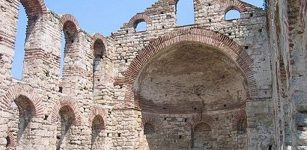 Ancient Nessebar – 3,000-Year-Old History Of Many Civilizations
Featured Stories | Jan 10, 2016
Ancient Nessebar – 3,000-Year-Old History Of Many Civilizations
Featured Stories | Jan 10, 2016 -
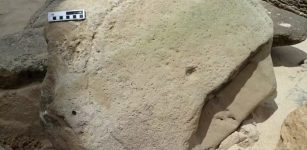 Our Ancestors Made Drawings In The Sand At The Beach 140,000 Years Ago – Scientists Say
Featured Stories | Jul 21, 2023
Our Ancestors Made Drawings In The Sand At The Beach 140,000 Years Ago – Scientists Say
Featured Stories | Jul 21, 2023 -
 Paris Of Troy: He Caused Destruction Of Troy As The Seer Had Predicted
Featured Stories | Mar 26, 2019
Paris Of Troy: He Caused Destruction Of Troy As The Seer Had Predicted
Featured Stories | Mar 26, 2019 -
 Mystery Of Ancient Sami People Buried Underwater – New DNA Breakthrough
Archaeology | Jun 12, 2019
Mystery Of Ancient Sami People Buried Underwater – New DNA Breakthrough
Archaeology | Jun 12, 2019 -
 Mysterious Engraved Bones Discovered On The Island Of Janitzio In Michoacán, Mexico
Archaeology | Jun 25, 2024
Mysterious Engraved Bones Discovered On The Island Of Janitzio In Michoacán, Mexico
Archaeology | Jun 25, 2024 -
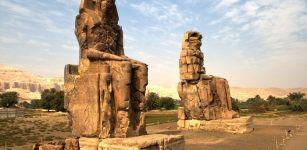 Colossi Of Memnon Guarded Temple Of Pharaoh Amenhotep III And Curious Sound Phenomenon
Featured Stories | Feb 2, 2021
Colossi Of Memnon Guarded Temple Of Pharaoh Amenhotep III And Curious Sound Phenomenon
Featured Stories | Feb 2, 2021 -
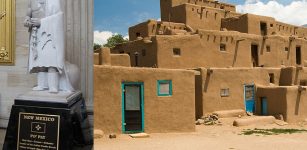 On This Day In History: Pueblo Indians Capture Santa Fe From The Spanish – On August 21, 1680
News | Aug 21, 2016
On This Day In History: Pueblo Indians Capture Santa Fe From The Spanish – On August 21, 1680
News | Aug 21, 2016 -
 Ambition, Greed And Death: The Roman Roots Of ‘Game Of Thrones’
Featured Stories | Jul 2, 2019
Ambition, Greed And Death: The Roman Roots Of ‘Game Of Thrones’
Featured Stories | Jul 2, 2019 -
 Yokai (Yōkai): Mysterious Interdimensional Force With Odd Abilities In Japanese Mythology
Featured Stories | May 15, 2017
Yokai (Yōkai): Mysterious Interdimensional Force With Odd Abilities In Japanese Mythology
Featured Stories | May 15, 2017 -
 Archaeologists Unearthed Alabaster Statue Of Queen Tiye In Luxor, Egypt
Archaeology | Mar 24, 2017
Archaeologists Unearthed Alabaster Statue Of Queen Tiye In Luxor, Egypt
Archaeology | Mar 24, 2017 -
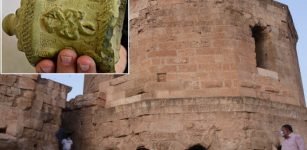 The Main Gate Of Historical 9th-Century Old Harran Palace Unearthed
Archaeology | Oct 25, 2020
The Main Gate Of Historical 9th-Century Old Harran Palace Unearthed
Archaeology | Oct 25, 2020 -
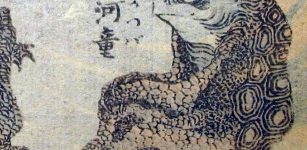 Mystery Of The Kappas That Moved Swiftly Over The Waters Or Across The Sky
Japanese Mythology | Jun 16, 2014
Mystery Of The Kappas That Moved Swiftly Over The Waters Or Across The Sky
Japanese Mythology | Jun 16, 2014 -
 Evolution Might Stop Humans From Solving Climate Change – Researchers Say
Evolution | Jan 3, 2024
Evolution Might Stop Humans From Solving Climate Change – Researchers Say
Evolution | Jan 3, 2024 -
 Little Known History Of Amazon’s Ashaninka People Studied By Researchers
Archaeology | Mar 21, 2023
Little Known History Of Amazon’s Ashaninka People Studied By Researchers
Archaeology | Mar 21, 2023 -
 Just 7% Of Our DNA Is Unique To Modern Humans – We Are Not Much Different From The Neanderthals
Archaeology | Jul 27, 2021
Just 7% Of Our DNA Is Unique To Modern Humans – We Are Not Much Different From The Neanderthals
Archaeology | Jul 27, 2021 -
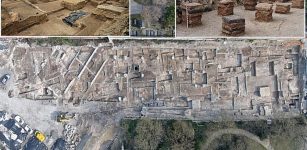 A Huge Site Dated To Roman-Era Unearthed In Reims (Marne), France
Archaeology | Mar 20, 2023
A Huge Site Dated To Roman-Era Unearthed In Reims (Marne), France
Archaeology | Mar 20, 2023 -
 Evidence Ancient Civilizations Had Knowledge About Planets In Our Solar System Thousand Years Ago
Featured Stories | Mar 10, 2021
Evidence Ancient Civilizations Had Knowledge About Planets In Our Solar System Thousand Years Ago
Featured Stories | Mar 10, 2021 -
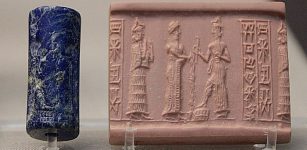 Shamash: Mesopotamian God Of Sun, Truth, Justice And Healing
Featured Stories | Jan 11, 2016
Shamash: Mesopotamian God Of Sun, Truth, Justice And Healing
Featured Stories | Jan 11, 2016 -
 Shining Swords: Magical Artifacts That Symbolized Power, War, Punishment And Righteousness
Featured Stories | Nov 20, 2024
Shining Swords: Magical Artifacts That Symbolized Power, War, Punishment And Righteousness
Featured Stories | Nov 20, 2024 -
 Shangshan Culture Drank Ancient Rice Beer 10,000 Years Ago – Archaeological Evidence Found In China
Archaeology | Dec 13, 2024
Shangshan Culture Drank Ancient Rice Beer 10,000 Years Ago – Archaeological Evidence Found In China
Archaeology | Dec 13, 2024



